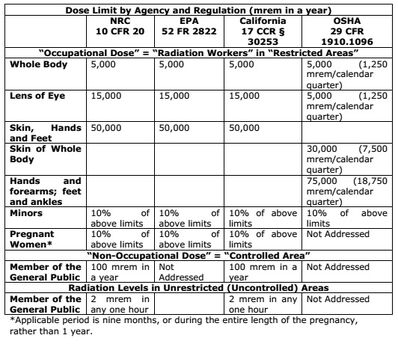About[]
Dose limits represent the upper bound limit below which risks from radiation exposure are deemed to be acceptable. Various federal and state regulations establish dose limits for occupational exposures that occur as a result of a person’s employment, and limits for the total exposures received by the public in general.
The classification, “occupational dose”, is the dose received by an individual in a restricted area or in the course of employment in which the individual’s assigned duties involves exposure to radiation and to radioactive material from licensed and unlicensed sources of radiation, whether in the possession of the licensee or other person. It does not include the dose received from background radiation, as a patient from medical practices, from voluntary participation in medical research programs, or as a member of the general public. The individuals subject to the occupational dose classification must closely monitor their degree of radiation exposure using dosimeters. The annual occupational dose limit for adults shall not exceed a total effective dose equivalent of 5 rem (5,000 mrem, 5,000,000 µrem).
Another radiation dose classification, “public dose”, is the dose received by a member of the public from exposure to radiation and to radioactive material released by a licensee, or to another source of radiation either within a licensee’s controlled area or in unrestricted areas. It does not include occupational dose or doses received from background radiation, as a patient from medical practices, or from voluntary participation in medical research programs. The total effective dose equivalent to individual members of the general public from the licensed operations shall not exceed 0.1 rem (100 mrem, 100,000µrem) in a year. A summary of pertinent dose limits is presented in Table 1.[1]

summary of radiation exposures
References[]